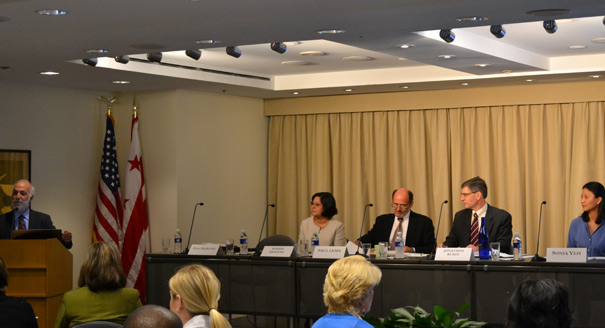Registration
You will receive an email confirming your registration.
IMGXYZ3846IMGZYXTransportation in the United States accounts for roughly two thirds of national oil consumption and one third of national greenhouse gas emissions. Transportation policy is therefore crucial to addressing U.S. energy security and global climate change.
Professor Madhu Khanna of the University of Illinois at Urbana-Champaign, Paul Leiby of the Oak Ridge National Laboratory, Jonathan Rubin of University of Maine, and Sonia Yeh of the University of California, Davis (UC Davis), presented and discussed the results of a two year collaborative study on the design and potential impact of a national low carbon fuel standard. Carnegie’s Kevin Tu gave the introduction. Dan Sperling, co-director of the study and a professor and founding director of the UC Davis Institute of Transportation Studies, moderated.
The Low Carbon Fuel Standard
- Technology Neutral: A low carbon fuel standard is a carbon intensity standard applied to a fuel’s life cycle, explained Sperling. This makes the low carbon fuel standard a technology neutral policy that harnesses market forces to stimulate innovation by allowing industry and consumers, instead of the government, to choose winners among competing fuel technologies and products, he added. One way to implement this new policy approach would be to use it to renew or enhance the already implemented renewable fuel standard.
- Inclusive Policy: A fuel standard would include all transportation fuels, from electricity to biofuels to yet unknown future products. Sperling explained such a policy would reward technological innovation and send the correct signals to industry and consumers.
Economic Benefits
- Reduced Costs: Khanna explained that adding the low carbon fuel standards to the existing renewable fuel standard, by broadening the pool of eligible fuels beyond biofuels and instituting a performance-based intensity standard, would increase innovation and reduce the cost of shifting away from petroleum.
- Reduced Pressure on Agricultural Lands: Shifting from food crop based biofuels to a broader set of alternative fuels, including the use of energy crops grown on marginal lands, would reduce pressure on lands for food production and thereby reduce upward pressure on food prices, added Khanna.
- Lower Fuel Prices: Using a reasonable set of assumptions about the path of innovation, Khanna explained that sufficient displacement of oil would reduce fossil fuel prices and bring down the cost of alternative fuels, making them competitive with traditional fuels and resulting in a net benefit for consumers by 2030. Consumer fuel prices could be reduced by as much as 10 percent by 2035, Khanna added.
Energy Security
- Economic Energy Security: Leiby defined energy security as the “protection of the U.S. economy against the risks of sustained high costs of energy imports as well as the risks of periodic shocks to supply and the high prices that occur along with those shocks.” According to this definition, Leiby said, energy security would benefit from the low carbon fuels standard through the replacement of imported oil by a variety domestic fuels.
- Energy Security Benefits: Leiby presented estimates for energy security benefits that range from $5 to $22 per barrel of oil displaced. The exact amount of benefit per barrel depends on the source of oil that is being replaced as well as the mix of fuel that replaces the oil, he said. The benefits are generally higher if imported oil is replaced and lower if domestic or North American oil is replaced. These cost estimates exclude military costs.
- Oil Security: The production and use of domestic and North American unconventional oils would continue in the United States under a low carbon fuels standard, Leiby said. The new standard would provide an incentive to reduce the carbon intensity of these fuel sources.
Market Forces
A carbon credit system that allows for trading credits among all fuel producers would provide a way to reduce uncertainties of future fuels and vehicle technologies, and also reduce the cost of meeting the performance targets, Rubin explained. Such a trading system could be designed to enhance price stability and eliminate price spikes.
Land Use
Even though there is still significant scientific uncertainty about the extent of land use changes, there is a general consensus among scientists that an increase in the production of biofuels will require additional lands and cause an increase in greenhouse gas emissions, Yeh said. These land use changes are expected to occur on an international scale as U.S. crop production and exports impact international crop production and trade.
- Land Use Change: Existing studies suggest that greenhouse gas emissions from land use change are greater for food crops, such as corn, and less for non-food crops, such as switch grass, which can be grown on degraded or marginal lands, said Yeh. Biofuel production from waste material would be best of all, resulting in essentially no greenhouse gas emissions from land use change, she added.
- Biofuel Policy: A policy portfolio approach is needed to address the issues associated with land use change. Yeh recommended the use of policies that incentivize the production of biofuel feedstock in a way that lowers the risk of land use changes.
